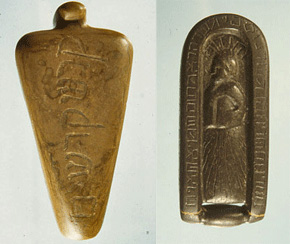FLINT RIDGE, COSHOCTON
THE NEWARK "HOLY STONES"
The Newark “Holy Stones” are one of the most famous scientific frauds in American history. In 1860, Newark surveyor David Wyrick “found” the first stone buried shallowly near the Octagon. The wedge-shaped stone was polished, and inscribed with some Hebrew characters. Five months later, he “found” another Hebrew-inscribed stone¸ this one encased in a stone box, in the remains of a large stone mound south of Newark. Wyrick and others declared the stones must be evidence of Israelite ancestry for the mound builders.
But the first stone was soon identified as a “key stone” used in the Masonic society’s rituals. Scholars pointed out that the Hebrew written on the second stone featured errors that only 19th century translators could have made. Scientific archaeologists have now decisively proven that the “holy stones” are fraudulent.
Perhaps more interesting is the remaining question of why Wyrick and the others would have done this. An answer may lie in a 19th century controversy over human origins. It was the time of the Civil War, and some were arguing that the peoples of Africa and the Americas were of a different species than Europeans. This view justified slavery and the taking of land from the Indians. The stones were probably meant to support the opposing idea that all people were of the same species, originating in Eden.
Despite the laudable goal of showing that the Indians were indeed human, turning them into descendants of Israelites unfortunately fed into racist myths that were popular at the time – that the sophisticated earthworks could not have been made by a non-white race.

The “Newark Holy Stones:” The Keystone (left) and Decalogue Stone (right) were “found” by David Wyrick in the Newark area (photos from Wikipedia Commons).


